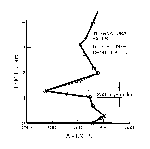
|
In Chapters 4 and 5 of Section VI unusual atmospheric conditions causing anomalous propagation of electromagnetic waves are described. In the present chapter an analysis is made of some of the most puzzling UFO phenomena. Most of them involve combined radar and visual contacts. All 31 combined radar-visual sightings, two visual-only, and two radar-only cases in the project files are analyzed in an effort to determine whether or not anomalous modes of propagation could account for the details of such sightings. Since both visual and radar sightings are analyzed below, readers whose familiarity with atmospheric propagation of light and radio waves is limited are urged to read Chapters 4 and 5, Section VI, before reading what follows in the present chapter.
In evaluating UFO phenomena it is seldom possible to arrive at an incontrovertible conclusion; rather, it is necessary to introduce admissable hypotheses and then attempt to determine the probability of their correctness through the study of generally inadequate data. In the case of the anomalous propagation hypothesis, extreme examples of anomalous propagation imply extreme conditions in the state of the atmosphere, and data on these unusual atmospheric conditions are either scarce or non-existent. Meteorological measurements that may be on record for a time and place appropriate to a particular UFO incident will usually be only generally indicative of the propagation conditions that existed during the incident. The meteorological instrumentation necessary to record the extremely sharp gradients of temperature [and] of humidity that are associated with strong partial reflections of electromagnetic waves is either beyond the state of the art or so difficult to
construct and operate that the measurements required have not yet been attempted.
Nevertheless, there is strong inferential evidence that such sharp gradients do exist in the atmosphere (see Section VI, Chapter 4), but experiments capable of detecting such gradients have not been made. The fact that, for example, a temperature change of 10°C over a distance of 1 cm. has not yet been observed in the free atmosphere is not proof that such gradients do not exist.
The following set of hypotheses were considered as possible explanations for each of the UFO phenomena studied:
The purpose of the investigation reported in this chapter was to determine, for the 35 cases included, the extent to which hypothesis No. 5, either alone or in combination with Nos. 2 and 3 could satisfactorily account for the circumstances of the UFO report. In each case the probability that some other hypothesis, such as Nos. 1 or 4, could more satisfactorily account for the sighting had to be evaluated.
There is always the danger in this sort of procedure that the true explanation for a particular event is not contained in a given set of a priori hypotheses. One obvious omission from the list above is the hypothesis that a particular UFO report was a hoax. Since
hoaxes are not part of the subject matter of this chapter, all cases have been studied under the assumption that all observers involved were reporting, to the best of their abilities and beliefs, the details of an event which they did not fully understand.
The 35 UFO cases examined in this chapter were classified using the following criteria:
I. Primarily visual This class includes those cases where the first and most significant contact was visual, or where the visual contact was preponderant and more positive than any radar contacts.
A. Star-like Cases where the visual reports were of one or more small, bright objects without pronounced motion, round or without definite shape. Cases where visual description appeared to be similar to a diffracted star-like object were also included.B. Meteor-like Cases where visual reports resembled meteor phenomena: rapidly moving star-like object, or small glowing object, with or without "smoke trails", sparks, fragmentation, etc.
C. Blurry light or glow Cases where descriptions were of a blurry or glowing object of undefined or amorphous shape.
D. Other Cases not fitting any of the above three criteria. Six cases were in this sub-group, including one dark, opaque, "jelly-fish" shaped object, three balloon-like objects, one aircraft-like object and one well-defined, structured saucer-shaped object.
II. Primarily radar This class includes those cases where the first and most significant contact was by radar, or where the radar contact was preponderant and more positive than any visual contacts.
A. AP-like Cases where the radar scopes showed a confused or random distribution of images, blips that showed erratic or discontinuous motion, or other patterns bearing a general similarity to anomalous propagation (AP) returns.[[175]]
B. Blip-like Cases where the radar target (or targets) showed characteristics similar to the return from a solid object (such as an aircraft, etc.), and where the target did not display erratic or discontinuous behavior. Acceleration or velocity in excess of known aircraft capabilities, or periods of immobility, were not considered to be contrary to normal target behavior.
In the following section cases of particular interest are treated in detail; these cases generally fall into one of three categories:
Two methods of presenting vertical profiles of radio refractivity in graphical form are used in this chapter. Both methods are based on the use of the radio refractivity, N, where
since the radio refractive index, n, is always very close to unity in the atmosphere. The maximum value of N that is likely to be encountered in the atmosphere is not much over 400; values close to 500 may occasionally be experienced over the surface of the Dead Sea, 1200 ft. below sea level, in the summer months.
A feature of all vertical profiles of N is a general decrease with height; the departures of any given profile from the average decrease with height are the significant features for anomalous propagation of radio waves. Therefore the refractive index profiles illustrated for many of the UFO cases in the following section are given in terms of A-units (Bean, 1966a) where
here N(z) is the actual refractivity profile, a function of height, z, in kilometers, and the last term represents the average decrease with height of an average radio refractivity profile
The number 313 is an average surface refractivity value. An N-profile that is not abnormal will, when plotted on a graph with A(z) as abscissa and z as ordinate, appear as a fairly. straight vertical line, perhaps with a slight tilt in one direction or the other. On the other hand, an N-profile with strongly super-refractive or subrefractive display a marked zigzag character on an A(z) vs. z plot. The use of A-units allows a more generous scale size for the abscissa than would be the case for N-unit plots.
Ray tracings, calculated and plotted by a digital computer, are illustrated for a few of the refractivity profiles. The computer also calculates the M-profile, and plots it on the same graph as the ray tracing. M-units are defined by
Where "a" is the radius of the earth. This is equivalent, to adding 156.9 N-units per km. to the observed profile. Since the ducting gradient (see Chapter VI-4) is -156.9 N. km-1, any layer with such a gradient will be represented on an M(z) plot as a vertical line. Layers with dN/dz > -156.9 km-1, (not ducting) will show a trace slanting up to the right, whereas strong ducts with dN/dz < -156.9 km-1 will show a trace slanting up to the left. Hence the M-unit plot is very convenient for exposing the existence or non-existence of radio ducts in N(z) data.
In the discussions that follow the UFO incidents are referred to by the case numbers assigned to them in the UFO project files. The
letter refers to the origin of the case: B-number cases are from USAF Project Blue Book files, N-numbers are for cases supplied by NICAP (National Investigations Committee for Aerial Phenomena), C-numbers refer to cases that were investigated by personnel of the Colorado project, and X-numbers were given to cases that were received after the cut-off date for inclusion in the regular files (i.e., after the computer analysis of all project file cases had already been completed). X-number cases are also identified by their B-, N-, or C- number.
CLASS I: PRIMARILY VISUALI-A: Star-like cases.I-B: Meteor-like cases. I-C: Blurry light or glow. 1-D: Miscellaneous appearance. CLASS II: PRIMARILY RADARII-A: Returns of an AP-like nature.II-B: Returns mostly single, sharp, aircraft-like. |
1321-B. This is a good example of a misidentified star combined with an apparently uncorrelated radar return causing an UFO report to be generated. The incident took place at Finland Air Force Base (60 mi. NE of Duluth), Minn., with a civilian sighting near Grand Marais, Minn., (50 mi. NE of Finland AFB) on the night of 5-6 September 1966, between 2130 and 0015 LST (0330-0615 GMT). The weather was clear, ceiling unlimited, visibility more than 15 mi.; a display of Aurora Borealis was in progress. Applicable radio refractivity profile is shown in Fig. 1. Visual reports of a "white-red-green" object "moving but not leaving its general location" were received at Finland AFB about 2130 LST. An FPS-90 search radar was activated but there was "too much clutter to see anything in that area ..." At 2200 LST a return was detected; it "flitted around in range from 13 to 54 mi.., but always stayed on the 270° azimuth." A pair of F-89s was scrambled from Duluth AFB and searched the area at altitudes of 8,000-10,000 ft. The two aircraft "merged with blip, apparently wrong altitude, no airborne sighting"; the radar operators insisted the target was at 8,000-10,000 ft., the same altitude at which the scrambled aircraft were flying. The pilots reported that they "only observed what was interpreted to be a beacon reflection."
Available meteorological data show that the winds were southwesterly, 7 knots at the surface, and northerly (320° to 30° at

|
25 to 65 knots aloft. The closest available radiosonde data (international Falls 1200 GMT 0600 LST) 6 September, show a temperature inversion and strong humidity lapse through a layer extending from 1029-1259 m. above the surface. The gradient of radio refractivity through this layer averaged -114N/km (corrected for radiosonde sensor lag). This layer would be expected to show a significant partial reflection at radio frequencies. If the layer were present over Finland AEB at the same elevation, it could have produced false targets by partial reflection of real ground targets, which would have appeared to be at altitudes of from 8,300-9,800 feet because of the geometry of such reflected targets (sec. Section VI, Chapter 5). This agrees well with the reported "UFO" altitudes of 8,000-10,000 ft.
Anomalous propagation echoes are not usually confined to a single direction. There are three possible explanations in this case and in other similar cases: a single real object was being tracked; the radar operators were not looking for targets on other azimuths; the partially reflecting layer may have been anisotropic (i.e. displaying a preferred direction for strongest reflection). There is no direct physical evidence for the existence of such anisotropic layers, but no studies have been made to determine whether or not they might exist. Apparent anisotropy in radar AP returns has often been observed, although not usually over such a narrow azimuth range as was apparently the case at Finland AFB.
Regarding the visual reports submitted, the comment of the investigating officer at Finland AFB is of particular interest:
The next evening, at 2200 hours, the "white-red-green" object reappeared in the sky at exactly the same position it had appeared on 5 September. This officer observed it and determined it to be a star which was near the horizon
and would settle beneath the horizon after midnight. It did appear to "sparkle" in red-green-white colors, but so do other stars which can be pointed out from this mountain top.
The officer refers to Rangoon Mountain, elevation 1,927 ft., from which many of the visual observations were made.
The star that the officer saw was in all probability Lambda Scorpio (Shaula) a magnitude 1.7 star at -37° declination and 17 hr. 31 min. right ascension. It would have set at just about 1:30 a.m. 90th meridian time, if the horizon were unobstructed. An obstruction of only 4° would cause Lambda Scorpio to "set" at 1:15 a.m. CST; a 4° angle is equivalent to a 35 ft. tree or building at a distance of 500 ft. The southerly declination would indicate that the star was in the southwest, which is compatible with the visual reports that were submitted.
Additional meteorological effects may have been present in this case. In particular, the southwesterly surface winds present are quite likely to have advected relatively cool, moist air from nearby Lake Superior under the elevated warm, dry layer noted previously, thus tending to increase the strength of the inversion and associated humidity lapse. Some of the optical effects noticed by the observers in this instance, strong red-green scintillation, apparent stretching of the image into a somewhat oval shape, and the red fringe on the bottom, may have been due to strong and irregular local refraction effects in the inversion layer (or layers).
This UFO report seems to have resulted from a combination of an unusually scintillating star and false radar targets caused by AP from a strong elevated layer in the atmosphere. This pattern is found in a number of other cases.
Reports with elements similar to the preceding case are:
113-B.* Nemuro AF Detachment, Hokkaido, Japan, 7 February 1953, 2230 LST (1230 GMT). Weather was clear. Visual description fits a scintillating star (flashing red and green, later white with intermittent
red and green flashes, then later steady white) rising in the east (only motion was slow gain in altitude, "[I believe] that the object did not move with respect to the stars in its vicinity"). CPS-5 radar painted a single pip at 85° azimuth, range 165 mi., which operator regarded as interference. Visual object was boresighted with radar antenna and azimuth read as 91°±2°. Elevation estimated as 15° initially (2230 LST). No stars brighter than magnitude 3 were in this azimuth between 0° and 30° elevation angle at that time. Blue Book file suggests Deneb or Regulus as likely objects, but their positions are far away from the sighted object. In view of two observers' comments that light "shown from beneath" object, it is very probable that they saw a lighted Pibal balloon, possibly launched from the Russian-held Kurile Islands to the east and northeast of Hokkaido (launch time 1200 GMT). The investigating officer noted the exceptionally good visibility prevalent in the area on clear nights.
1306-B. Edwards AFB, Kernville, Calif., 30 July 1967, 2217-2400 LST. Weather: clear, calm, warm (83°F). Two civilians reported observing one or two blue, star-like objects that appeared to circle, bob, and zigzag about a seemingly fixed star; these objects "instantly disappeared" about 1 hr. 45 min. after sighting. Edwards AFB RAPC0N radar picked up "something" at about 2230 LST "for several sweeps." Blip seemed to be moving south at about 50-60 mph. There is no apparent connection between the radar and visual reports. The visual UFO did not appear to move at 50-60 mph. Data, including weather data, on this report are insufficient to form an opinion. The most likely possibility seems to be that the visual LJFO consisted of the direct image plus one or two reflected images of the "fixed star" that the observer reported. What may have produced the reflected images remains conjectural. For example, a turbulent layer of air with strong temperature contrasts could produce images similar to those described by the witnesses. The instantaneous disappearance of the UFOs is consistent with an optical phenomenon.
As for the radar "track", a blip appearing for only "a few sweeps" could be almost anything: noise, AP, or possibly a real target flying near the lower limits of the radar beam.
1212-B. Tillamook, Ore., 13-14 March 1967, 2230-0008 LST. Weather: clear with "stars plainly visible," some ground fog, thin broken cirriform clouds estimated at 10,000 ft., visibility 15 mi. This is a good example of some of the confusion that arises in reporting UFO incidents. Initial visual observer reports indicated object at about 45° to 50° elevation angle, yet when the Mt. Hebo radar station "contacted target" it was at 39 mi. range, 9,200 ft. height. This is an elevation angle of only about 2°. This inconsistency seems to have gone unnoticed in the Project Blue Book file on the case. The radar target, as plotted, stayed at 39 mi. range and slowly increased height to 11,200 ft., then shifted almost instantaneously to 48 mi. range. Subsequently the radar target slowly gained altitude and range, disappearing at 55 mi. and 14,000 ft. (still at about a 2° elevation angle). The azimuth varied between 332° and 341° during this time. Average apparent speed of the radar track was low: the first part of the track was at zero ground speed and a climb rate of about 100 ft/min, the second part of the track was at an average ground speed of about 16 mph. and a climb rate of about 100 ft/min. In between there is a jump of 9 mi. range in one minute, a speed of 540 mph. The characteristics of this radar track are suggestive of radar false targets or slow-moving AP echoes. The jump may be a point where one echo was lost, and another, different echo began coming in. This effect is apparently a frequent cause of very high reported speeds of UFOs (Borden, 1953). The visual reports are suggestive of either a scintillating star if the reported angle is higher than actual, or an aircraft. There was an electronic warfare aircraft "orbiting" at high altitude seaward of Tillamook at the time of the sighting, and
it seems quite plausible that this was the visual UFO. However, this was discounted in the Blue Book report because the aircraft's position it did not check with the radar contact.
115-B. Carswell AFB (Fort Worth area), Tex., 13 February 1953, 0235 LST. Weather: clear with visibility unlimited; temperature inversion layer with sharp humidity lapse at 3,070 ft. altitude, elevated radio duct at 4,240 ft. altitude. Applicable refractivity profile for 0300 LST shown in Fig.. 2. Visual observers saw a "formation" of three bright lights which performed a series of maneuvers suggestive of an aircraft with landing lights doing several rolls and then climbing rapidly and heading away. Operators then attempted to pick up the object on an APG 41 radar, and after about two minutes they brought in two apparently stationary targets on the correct azimuth. It seems likely that these returns were from ground objects seen via partial reflection from the strong elevated layers (gradients -154 and -311 km-1). The visual sighting was probably an aircraft.
237-B. Haneda AFB (Tokyo), Japan, 5-6 August 1952, 2330-0030 LST. Weather: "exceptionally good," 0.3 cloud cover about 10 mi. north and 10 mi. south of the contact area, "excellent visibility," isolated patches of low clouds, Mt. Fuji (60 n. mi.) "clearly discernible," scattered thunderstorms in mountains northwest, temperature at Haneda 78° F, dew point 73° F. Observers saw a bright, round light (about 1 mrad arc) surrounded by an apparently dark field four times larger, the lower circumference of which tended to show some bright beading. It was low in the sky at about 30° -50° azimuth. Object appeared to fade twice, during which time it appeared as a dim point source. It disappeared, possibly becoming obscured by clouds, after about an hour. The sky at Haneda AFB was overcast by 0100 LST. One of the visual observers noted that near the end of the sighting the object seemed somewhat higher in the sky and that the moon seemed proportionately higher in elevation. The pilot of a C-54 aircraft coming in for a
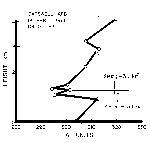
|
landing was directed to observe the object and he replied that it looked like a brilliant star, and he dismissed the sighting as such.
When the controller at Shiroi AFB was asked to look for target on GCI radar, he could find nothing for 15 min. He stated: "There were three or four blips on low beam but none I could definitely get a movement on or none I could get a reading on the RHI (range-height indicator) scope." A new controller taking over at 2345 LST "believed" he made radar contact with the object and an F-94 was scrambled. This officer stated: "The target was in a right orbit moving at varying speeds. It was impossible to estimate speed due to the short distances and times involved." By the time the F-94 arrived in the area of the "bogie," Shiroi GCI had lost radar contact; regaining contact at 0017 LST "on a starboard orbit in the same area as before." The F-94 was vectored in to the target, and at this point the timing becomes confused. The Shiroi controller states that the F-94 "reported contact at 0025 (LST) and reported losing contact at 0028 (LST)." The F-94 radar operator states: "At 0016 (LST) I picked up a radar contact at 10° port, 10° below, at 6,000 yd. The target was rapidly moving from port to starboard and a lock-on could not be accomplished. A turn to the starboard was instigated [sic] to intercept target which disappeared on scope in approximately 90 sec. No visual contact was made with the unidentified target." Shiroi GCI had lost the F-94 in ground clutter, and had also lost the target. It is not clear whether the GCI radar ever tracked the fast-moving target described by the F-94 crew. The maximum range of the F-94's radar is not given in the Blue Book report.
The F-94 pilot stated that the weather was very good with "exceptional visibility of 60-70 miles," yet this fast-moving UFO, obviously far exceeding the F-94's airspeed about 375 knots), was seen by neither the aircraft crew nor the observers on the ground at Shiroi GCI even though the UFO track crossed over very close to Shiroi GCI number four. There are many other inconsistencies in the
report of the incident besides the timing and the lack of visual contact by the F-94 crew. The bright, quasi-stationary object sighted NE of Haneda AFB, and seen also from Tachikawa AFB (about 30 mi. west of Haneda AFB), should have been visible to the south of Shiroi AFB, but was never seen by any of a large number of persons there who attempted such observations. Also, at 0012 LST the object being tracked by GCI's CPS-l radar reportedly "broke into three smaller contacts maintaining an interval of about 1/4 mile." The blips on the CPS-l were described as small and relatively weak, but sharply defined.
Two things seem apparent:
The first statement is supported by the inability of the observers at Shiroi to see anything to the south; the second statement is supported by numerous inconsistencies between the visual and radar sightings. The two most important of these latter are:
The most likely light source to have produced the visual object is the star Capella (magnitude 0.2), which was 8° above horizon at 37° azimuth at 2400 LST. The precise nature of the optical propagation mechanism that would have produced such a strangely diffracted image as reported by the Haneda AFB observers must remain conjectural. Complete weather data are not available for this case, but it is known that the light SSE circulation of moist air from Tokyo Bay was overlain by a drier SW flow aloft. A sharp temperature inversion may have existed at the top of this moist layer, below which patches of fog or
mist could collect. The observed diffraction pattern could have been produced by either
In either event, the phenomenon must he quite rare. The brightness of the image may have been due in part to "Raman brightening" of an image seen through an inversion layer.
Nor can exact nature of the radar propagation effects be evaluated, due to the lack of complete weather data. However, a substantial inference that the radar returns were of an anomalous propagation nature is derived from:
Singly, each of the above could be interpreted in a different light, but taken together they are quite suggestive of an anomalous propagation cause.
In summary, it appears that the most probable causes of this UFO report are an optical effect on a bright light source that produced the visual sighting and unusual radar propagation effects that produced the apparent UFO tracks on radar.
104-B. Goose AFB, Labrador, 15 December 1952, 1915-1940 Local Mean Solar Time. Weather: clear and visibility unlimited (30 mi.). The crews of an F-94B fighter and a T-33 jet trainer saw a bright red and white object at 27° azimuth while flying at 14,000 ft. The aircraft attempted an intercept at 375 knots indicated air speed, but
could not close on the UFO. After 25 min. of reported chase, although the aircraft had covered a distance of only about 20 mi. (about 3.5 min. at 350 knots ground speed) the object faded and disappeared. During the chase, the radar operator in the F-94B had a momentary lock-on to an unknown target at about the correct azimuth for the UFO. Since this was so brief, it was felt (by Air Intelligence, presumably) that the set had malfunctioned. No GCI contact was made.
The official Air Force explanation for this UFO incident is that the aircraft were chasing Venus which was setting about the time of the sighting, and that the radar "target" was simply a malfunction. It seems likely that this explanation is essentially correct. However, it is unlikely that experienced pilots would have chased a normal-appearing setting Venus. It is more probable that the image of Venus was distorted by some optical effect, possibly a slight superior mirage, and that loss of the mirage-effect (or the interposing of a cloud layer) caused the image to fade away. All items of the account may be explained by this hypothesis, including the report that the object had "no definite size or shape," as the image would no doubt be somewhat "smeared" by imperfections in the mirage-producing surface. The small-angle requirement of a mirage is satisfied since the pilots reported the object seemed to stay at the same level as the aircraft, regardless of altitude changes that they made (another indication of great distance).
14-N. This file actually consists of two similar cases reported by a Capital Airlines pilot with 17 years and 3,000,000 mi. logged. The first case occurred over central Alabama the night of 14 November 1956; the second case was on the night of 30 August 1957, over Chesapeake Bay near Norfolk, Va.
The first sighting took place about 60 mi. NNE of Mobile, Ala. while on a flight from New York to Mobile in a Viscount at "high altitude," probably about 25,000 ft. It was a moonless, starry night
and there was an occasionally broken undercast. The object seen was described as an intense blue-white light about 1/10 the size of the moon (~3' arc) and about "seven or eight times as bright as Venus at its brightest magnitude." It first appeared 2210 LST at the upper left of the Viscount's windshield falling towards the right and decelerating rapidly as a normal meteor would. Pilot and co-pilot both took it to be an unusually brilliant meteor. However, this "meteor" did not burn out as expected, but "abruptly halted directly in front of us and began to hover motionless." The aircraft at this time was over Jackson, Ala. and had descended to 10,000 ft. The pilot contacted Bates Field control tower in Mobile and asked if they could see the object which he described to them as "a brilliant white light bulb." They could not see it. The pilot then asked Bates to contact nearby Brookley AFB to see if they could plot the object on radar. He never learned what the result of this request had been. The object began maneuvering "darting hither and yon, rising and falling in undulating f light, making sharper turns than any known aircraft, sometimes changing direction 90° in an instant -- the color remained constant, -- and the object did not grow or lessen in size. "After a "half minute or so" of this maneuvering, the object suddenly became motionless again. Again, the object "began another series of crazy gyrations, lazy eights, square chandelles, all the while weaving through the air with a sort of rhythmic, undulating cadence." Following this last exhibition, the object "shot out over the Gulf of Mexico, rising at the most breath-taking angle and at such a fantastic speed that it diminished rapidly to a pinpoint and was swallowed up in the night."
The whole incident took about two minutes. The pilot remembers noting that the time was 2212 EST. The object appeared to be at the same distance from the aircraft, which was flying a little faster than 300 mph. during the entire episode.
The second incident reported by this pilot, the 30 August 1957, Chesapeake Bay report, occurred as he was flying another Capital Airlines Viscount at 12,000 ft. approaching Norfolk, Va. There was a Northeast Airlines DC-6 flying at 20,000 ft. "directly above" the Viscount. In this case, the object "was brilliant; it flew fast and then abruptly halted 20 mi. in front of us at 60,000 ft. altitude." The Northeast pilot looked for the object on radar and "could get no return on his screen with the antenna straight ahead but when tilted upward 15° he got an excellent blip right where I told him to look for the object."
This object "dissolved right in front of my eyes, and the crew above lost it from the scope at the same time. They said it just faded away. This sighting covered "several minutes."
These two similar sightings are very difficult to account for. The first sighting over Alabama has most of the characteristics of an optical mirage: an object at about the same altitude seeming to "pace" the aircraft, the meanderings being easily accountable for as normal "image wander." However, there are two aspects that negate this hypothesis:
The second sighting is equally difficult to explain as a mirage, which seems to be the only admissable natural explanation in view of the pilot's experience as an observer. The reasons are twofold:
with a mirage;
The pilot stated that the Northeast DC-6 flying at 20,000 ft. "painted" the UFO at 15° elevation and a range of 20 mi. This would place the UFO at about 48,500 ft., the pilots estimate of 60,000 ft. apparently being in error. Presumably then, the elevation angle as viewed from the Capital Viscount was about 19°. It is very unlikely that any temperature inversion sufficient to produce a mirage would be tilted at such an angle. For a near-horizontal layer to have produced such an image (plus the radar return) by partial reflection of a ground-based object seems equally unlikely. The largest optical partial reflection that such a layer might produce at an angle of 19° would be about 10-14 as bright as the object reflected (see Section VI, Chapter 4). This is a decrease of 35 magnitudes. Such a dim object would be ordinarily invisible to the unaided eye.
In summary, these two cases must be considered as unknowns.
1065-B. Charleston, S. C., 16 January 1967, 1810 LST. The observational data in this case are insufficient to determine a probable cause for the sighting. A civilian "walked out of his house and saw" two round objects. He estimated that they were about 30° above the horizon. They appeared to be "silver and blue, with a red ring." These objects were alternately side by side and one above the other, and a beam of light issued "from the tail end." The observer does not state how he knew which was the "tail end," or even at what azimuth he saw the objects. They "vanished in place," still at 30° elevation. After the Charleston AFB was notified of the sighting, some unidentified returns were picked up on an MPS-14 search radar. An investigating officer later determined that these returns were spurious. The case file states:
[The officer] called [8 March 1967] to provide additional information in regard to the radar sighting. [The officer] was informed by the Charleston AFB that the radar paints were not of UFOs. A check of the equipment was made and it was learned that the individual monitoring the radar set had the "gain" [control] on the height finder turned up to the "high" position. This caused the appearance of a lot of interference on the radar scope. Personnel at Charleston AFB determined the paints on the radar to be this interference. The personnel turned the gain on high again and picked up more "UFOs". When the gain was turned down the UFOs disappeared.
There apparently were no radar UFOs in this case. The residue is a visual sighting by a single observer with insufficient data for evaluation. What the observer saw could conceivably have been
1323-B. Sault Saint Marie AFB, Mich., 18 September 1966, 0100 LST. Weather: clear, calm. There is a very brief Blue Book file on this incident. Two sergeants of the 753rd Radar Squadron saw a bright light, ellliptical in shape and apparently multicolored of unsaturated hues, which appeared low over the treetops to the SE and moved in a straight line toward the west, disappearing "instantaneously" in the WSW. Duration of this sighting was 2-5 sec. The report states that the object was also tracked by a long-range AN/FPS-90 heightfinder with azimuth, range, and altitude "available on request." Since this
information is not included in the folder, no firm conclusion may be reached as to the probable cause of the radar sighting or even as to whether or not the radar and visual objects were correlated.
The general visual appearance, brightness range, motion and mode of disappearance are all compatible with the hypothesis that the object was a large meteor. Some large meteors display even more unusual appearance than this report. If it was a meteor, the radar may have actually tracked it; radar tracks of large meteors are not unknown. Of course, the radar track may have been spurious, or may have indicated that the object was unnatural. The tracking data would be required to settle the point.
The radio refractivity profile for 0600 LST, shown if Fig. 3 indicates that an intense super-refractive layer existed within the first 372 m. (1220 ft.) above the surface. This profile is conducive to the formation of AP echoes on ground-based radar, so there is some possibility that the observed radar data in this UFO incident may have been spurious. This case would seem to merit further investigation.
1206-N. Edmonton, Alberta, 6 April 1967, 2125-2200 LST. Weather: "very clear," cool, temperature about 35°F, little or no wind at surface, stars "bright," no moon. Observers state that a bright object appeared in the NNW low on the horizon, moving fast, appeared to hover, and then disappeared. The night before, a whitish object like a normal star "only much larger" had appeared in the same place (NNW). A Pacific Western Airlines pilot independently reported "chasing" a UFO whose position was relayed to him by GCA radar from Edmonton International Airport. This UFO appeared to move somewhat erratically, was seen only briefly by the pilot as a "reddish-orange lighted effect," and did not travel the same course as the visual object described above.
The general atmospheric conditions prevailing during this sighting were conducive to AP. The description of the GCA radar track is suggestive of AP (quasi-stationary target appearing to "jump" in position), and the description of the UFO of 5 April is suggestive of the diffracted image of a star seen through a sharp temperature
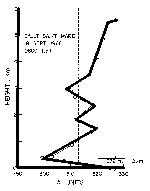
|
inversion. In the absence of detailed meteorological data, the most probable conc1usion seems to be that the primary sighting was a meteor and that no genuine UFO case exists here. However, this case also might merit a more intensive investigation.
1207-B. Paris, Tex., 7 March 1967, 1645 LST. Weather: clear, visibility 15 mi. This is an unconfirmed report by a single observer who could not even be reached for verification of the report by members of this project staff. He claimed to have seen two lights that "made a 90° turn at high speed, appeared to separate and come back together again and then went straight up. Speed varied from fast to slow to fast, in excess of known aircraft speed." The last statement is the witness's interpretation. He stated that radar at Paris AFB had tracked this UFO, but all military radar installations in the area disclaim any UFO tracks that night. It seems probable that the visual sighting was either an aircraft, whose sound was not heard by the witness for some reason, or a pair of meteors on close, nearly parallel paths. The quick dimming of a meteor burning out may be interpreted as a 90° turn with sudden acceleration away from the observer of a nearly-constant light source, which then seems to disappear in the distance.
15-B. Blackhawk and Rapid City, S. Dak., and Bismarck, N. Dak., 5-6 August 1953, 2005-0250 LST. Weather: clear, excellent visibility, stable conditions, temperature inversions and radio surface ducts prevalent. See Fig. 4. The night was dark and moonless.
The initial incident in this chain of UFO sightings was the sighting by a GOC (Ground Observers Corps) observer of a stationary "red glowing light" at 2005 LST near Blackhawk, S. Dak. This light soon began to move some 30° to the right, "shot straight up," and moved to the left, returning to its original position. A companion thought it was "just the red tower light" (a warning light on an FM
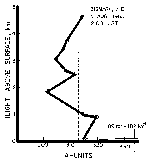
|
transmitter tower normally just visible from their location). The report was relayed to the Rapid City Filter Center, and three airmen from the radar site were sent outside to look for the UFO. They saw what was undoubtedly a meteor, judging from their description. The radar operator when informed of the new sighting began to search for unidentified targets. He found many.
Over the course of the next four hours a large number of unidentified blips appeared on the Rapid City radar. Many of those were transitory, moving blips with a fairly short lifetime, usually being "lost in the ground clutter." An F-84 fighter was vectored in to a stationary blip near Blackhawk, and the pilot "chased" a UFO which he found at the location on a heading of 320 ° M. without gaining on it. The F-84 was probably chasing a star, in this case Pollux (mag. 1.2) which was in the correct location (335° true azimuth, near the horizon).
When the Blackhawk GOC post called in that the original object had returned for a third time, another F-84 was vectored in on the visual report. as no radar contact could be made. The pilot made a visual contact" and headed out on a 360 ° magnetic (~15° true) vector. At this point the radar picked up what apparently was ghost echo, that is, one that "paced" the aircraft, always on the far side from the radar. The fighter in this instance was probably chasing another star, the image of which may have been somewhat distorted. The pilot's report that the visual UFO was "pacing" him appears to have strengthened the radar operator's belief that he was actually tracking the UFO, and not a ghost echo. The star in this instance may well have been Mirfak (mag. 1.9), which, at 2040 LST, was at azimuth 15 ° and about 5 ° to 7 ° elevation angle. The second pilot, upon being interviewed by Dr. Hynek, stated that he felt he had been chasing a star, although there were some aspects of the
appearance of the object that disturbed him. He also stated that the radar gunlock. which he had reported by radio during the chase, was due to equipment malfunction, and that the radar gunsight continued to malfunction on his way back to the base. This equipment was never subsequently checked for malfunctioning (i.e., not before or during the official AF investigation of the incident).
The Bismarck, N. Dak. sightings began when the Bismarck Filter Center was alerted to the "presence of UFO's" by Rapid City. At 2342 LST the sergeant on duty there and several volunteer observers went out on the roof and shortly spotted four objects. The descriptions of these objects by the various observers were consistent with the hypothesis that they were stars, although some apparent discrepancies caused early AF investigators to deduce by crude triangulations that the sighted objects must have been nearby. It now appears that all four objects were stars viewed through a temperature inversion layer. The observers stated that the objects resembled stars, but that their apparent motion and color changes seemed to rule out this possibility.
Dr. Hynek's summary of the probable nature of the four Bismarck objects is enlightening:
Object #1, which was low on the horizon in the west and disappeared between midnight and 0100 hr. was the star Arcturus observed through a surface inversion. Arcturus was low on the horizon in the west and set at approximately 1220 (LST) at 289 ° azimuth.
Object #2 -- was the star Capella observed through a surface inversion. At 0011 CST Capella was at 40° azimuth and 15 ° elevation ... [and] at 0200 CST [it] was at 53° azimuth and 30 ° elevation, which agrees with the positions given by [the two witnesses].
Objects #3 and #4 were, with a high degree of probability, the planet Jupiter and the star Betelgeuse, observed through
a surface inversion. Jupiter's ... stellar magnitude was -1.7 [and it] was low on the eastern horizon at approximately 92° azimuth. Betelgeuse ... was also low on the eastern horizon at approximately 81 ° azimuth.
The statement of one of the witnesses at Bismark includes the following comments:
... they appeared much brighter than most of the stars and at times appeared to take ona rather dull bluish tint.
They appeared to move in the heavens, but at a rather slow rate and unless a person braced his head against some stationary object to eliminate head movement it would be hard to tell that they were moving.
The one in the west eventually disappeared below the horizon and the one in the northeast gradually seemed to blend in with the rest of the stars until it was no longer visible.
The last statement is typical of the description given by witnesses who have apparently observed a bright star rising through an inversion layer. It would seem to be circumstantial evidence of the diffraction-brightening predicted by Raman for propagation along an inversion layer (see Section VI Chapter 4). However, there is an alternative explanation that simple diffractive blurring or smearing of a star's image, by spreading the available light over a larger area of the eye's retina, may cause a psychological illusion of brightening of the object.
The meteorological conditions were generally favorable for anomalous propagation at both locations. The refractivity profile for Rapid City 2000 LST 5 August shows a 0.5 ° C temperature inversion over a layer 109 m. thick, although the resulting refractivity gradient is only -77 km-1 (Fig. 5). The 0800 LST profile (Fig. 6) shows a pronounced elevated
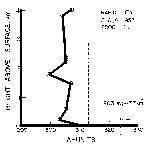
|
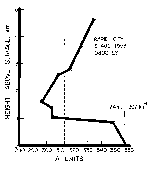
|
duct between 833 and 1,007 m. with a gradient of -297 km-1; a 3.2 ° elevated inversion is reported through this layer. A strong inversion layer evidently formed during the night and was "lifted" to the 833 m. level by solar heating after sunrise at about 0500 LST.
The Bismarck profile for 2100 LST 5 August (Fig. 4) shows a 1.2°C temperature inversion between the surface and the 109 m. level, the resulting layer forming a radio duct with a refractivity gradient -182 km-1. It is noteworthy that the Bismarck sightings show more evidence of optical inversion-layer effects than the Rapid City sightings.
In summary, the Rapid City-Bismarck sightings appear to have been caused by a combination of:
Case 5*. Louisianna-Texas (Ft. Worth) area, 19 September 1957, sometime between midnight and 0300 LST.
The weather was clear. The radio refractive index profiles for Ft. Worth, for 1730 and 0530 LST, 18-19 September 1957, are shown in Figs. 7 and 8. The aircraft was flying at an altitude between 30,000 and 35,000 ft. as recalled 10 years later by the witnesses involved. There was a slight temperature inversion at an altitude of 34,000 ft., which may have been associated with a jet stream to the north.
There is a possibility that a very thin, intense temperature inversion was present that night over certain localized areas at an altitude of about 34,000 ft., a layer capable of giving strong reflections at both radar and optical frequencies. There are many aspects of the visual appearance of the UFO that are strongly suggestive of optical phenomena: the bright, white light without apparent substance, the
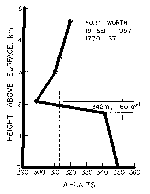
|
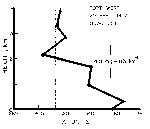
|
turning on and off "like throwing a switch," the amorphous red glow without "any shape or anything of this nature." The radio refractivity profile for the time of the sighting, with several strong super-refractive layers, is conducive to the formation of radar AP echoes. The description of the GCl radar targets is suggestive of AP phenomena:
All of a sudden they would lose it, or something. They had it and then they didn't, they weren't sure. There was a lot of confusion involved in it. They'd give you these headings to fly. It would appear to just -- they had maybe a hovering -- capability and then it would just be in a different location in no time at all.
This type of behavior is typical of moving AP targets. The elevated duct shown on the Fort Worth profiles is very thick, and seems fully capable of causing these effects.
In summary, it is possible to account for the major details of the sighting through three hypotheses:
There are many unexplained aspects to this sighting, however, and a solution such as is given above, although possible, does not seem highly probable. One of the most disturbing features of the
report is the radar operator's insistence, referring to ground and airborne radars, that " ... this would all happen simultaneously. Whenever we'd lose it, we'd all lose it. There were no "buts" about it, it went off." Another unexplained aspect is the large range of distances, bearing angles, and to some extent, altitudes covered by the UFO. The radar operator's comment that the return "had all the characteristics of -- a ground site -- CPS6B," indicates that an airborne radar source is unlikely due to the large power requirements. There remains the possibility that the "red glow" was the mirage of Oklahoma City which was in about the right direction for the original "red glow" and presumably had a CPS6B radar installation, but subsequent direction and location changes would seem to rule out this possibility and the grazing angle at the elevated inversion layer would be too large for a normal mirage to take place.
In view of these considerations, and the fact that additional information on this incident is not available, no tenable conclusion can be reached. From a propagation standpoint, this sighting must be tentatively classified as an unknown.
Over Labrador, 30 June 1954, 2105-2127 LST. Weather: (at 19,000 ft.) clear, with a broken layer of stratocumulus clouds below, excellent visibility. No radar contact was made in this incident. A summary of the pilot's first-hand account of his experience reads:
I was in command of a BOAC Boeing Strato cruiser en route from New York to London via Goose Bay Labrador (refuelling stop). Soon after crossing overhead Seven Islands at 19,000 feet, True
Airspeed 230 kts, both my copilot and I became aware of something moving along off our port beam at a lower altitude at a distance of maybe five miles, in and out of a broken layer of Strato Cumulus cloud. As we watched, these objects climbed above the cloud and we could now clearly see one large and six small. As we flew on towards Goose Bay the large object began to change shape and the smaller to move relative to the larger....
We informed Goose Bay that we had something odd in sight and they made arrangements to vector a fighter (F94?) on to us. Later I changed radio frequency to contact this fighter; the pilot told me he had me in sight on radar closing me head-on at 20 miles. At that the small objects seemed to enter the larger, and then the big one shrank. I gave a description of this to the fighter and a bearing of the objects from me. I then had to change back to Goose frequency for descent clearance. I don't know if the fighter saw anything, as he hadn't landed when I left Goose for London.
The description of the UFO in this case, an opaque, dark "jellyfish-like" object, constantly changing shape, is suggestive of an optical cause. Very little meteorological data are available for this part of the world on the date in question, so that the presence of significant optical propagation mechanisms can be neither confirmed nor ruled out. Nevertheless, certain facts in the case are strongly
suggestive of an optical mirage phenomenon:
The suggestion is strong that the UFO in this case was a mirage: a reflection of the dark terrain below seen against the bright, "silvery" sky to the left of the setting sun. The reflecting layer would be a thin, sharp temperature inversion located at an altitude just above that of the cruising aircraft. Most of the facts in this incident can be accounted for by this hypothesis. The dark, opaque nature of the image arises from the contrast in brightness and the phenomenon of "total reflection." The arrangement of the large and small objects in a thin line just above the aircraft's flight path, as well as the manner of disappearance, are commensurate with a mirage As the mirage-producing layer weakens (with distance) or the viewing angle increases (was the aircraft beginning its descent at the time?), the mirage appears to dwindle to a point and disappears. This type of mirage is referred to as a superior mirage and has often been reported over the ocean (see Section VI, Chapter 4).
The principal difficulty with this explanation, besides having to hypothesize the existence of the mirage-producing layer, is how to account for the anisotropy of the mirage. Anisotropy of this sort, i.e., a mirage limited to certain viewing azimuths, is common in earth-bound mirages when viewed from a single location. But a mirage layer through which a reflected image could be seen only in one, constant principal direction (plus a few small "satellite" images) over a distance of 85 n. mi. is quite unusual.
There remains the slim possibility that the aircraft itself produced the mirage layer through intensification (by compression induced by the shockwave of the aircraft's passage through the air) of a barely subcritical layer, i.e., one in which the temperature gradient is just a little bit less than the value required to produce a mirage. This hypothesis would satisfy the directional requirement of the sighting, but the resulting scheme of hypotheses is too speculative to form an acceptable solution to the incident.
This unusual sighting should therefore be assigned to the category of some almost certainly natural phenomenon, which is so rare that it apparently has never been reported before or since.
304-B. Odessa, Wash., 10 December 1952, 1915 LST. Weather: clear above undercast at 3,000 ft.; aircraft at 26,000-27,000 ft. Two pilots in an F-94 aircraft sighted a large, round white object "larger than any known type of aircraft." A dim reddish-white light seemed to come from two "windows." It appeared to be able to "reverse direction almost instantly," and did a chandelle in front of the aircraft. After this the object appeared to rush toward the aircraft head-on and then would "suddenly stop and be pulling off." The pilot banked away to avoid an apparently imminent collision, and lost visual contact. Fifteen minutes later the aircraft radar picked up something which the crew assumed was the UFO, although there
is no evidence that it was. The object was reported to be moving generally from west to east at 75 knots. It was never sighted.
This sighting has been described as a mirage of Venus, although the reported 75 knot speed and 270° direction of motion is in contradiction to this hypothesis. The general description of the object as well as the reported motion is suggestive of a weather balloon. However, the peculiar reversals of direction, although they could have been illusory, and particularly the loss of visual contact are at odds with the balloon hypothesis.
The radiosonde profile for Spokane, 1900 LST, is shown in Fig.9 and is inconclusive. The tropopause, where the sharpest temperature inversions are likely, is at about 30,500 ft. above sea level, too high to have produced a mirage visible at 26,000 -27,000 ft.
The closeness of the timing between the radiosonde release at 1900 LST and the sighting at 1915 LST suggests that the F-94 crew may have seen a lighted pibal balloon. The description given, including the two dimly-lit "windows," is typical of the description of a pibal balloon by those not familiar with weather instrumentation. Such a balloon would rise to at least 17,000 ft. in 15 min., and the reported motion, 270° at 75 knots, is in excellent agreement with the upper winds at the highest level plotted for the Spokane profile: 280° at 66 knots at 18,000 ft.
19-X. [361-B]. Kirtland AFB, Albuquerque, N.M., 4 Nov. 1957, 2245-2305 LST. Weather: scattered clouds with high overcast, visibility good, thunder-storms and rain showers in vicinity, light rain over airfield. Observers in the CAA (now FAA) control tower saw an unidentified dark object with a white light underneath, about the "shape of an automobile on end," that crossed the field at about 1500 ft. and circled as if to come in for a landing on the E-W runway. This unidentified object appeared to reverse direction at low altitude, while out of sight of the observers behind some buildings, and climbed suddenly to about
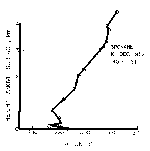
|
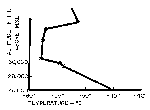
|
200-300 ft., heading away from the field on a 120° course. Then it went into a steep climb and disappeared into the overcast.
The Air Force view is that this UFO was a small, powerful private aircraft, flying without flight plan, that became confused and attempted a landing at the wrong airport. The pilot apparently realized his error when he saw a brightly-lit restricted area, which was at the point where the object reversed direction. The radar blip was described by the operator as a "perfectly normal aircraft return," and the radar track showed no characteristics that would have been beyond the capabilities of the more powerful private aircraft available at the time. There seems to be no reason to doubt the accuracy of this analysis.
1482-N. About 15 mi. east of Utica, N. Y., 23 June 1955, 1215-1245 LST. Weather: overcast at 4,000 ft., visibility good below. Reported by the co-pilot of a Mohawk Airlines DC-3. They were cruising at 3,000 ft. at 160 knots, when he noticed an object passing approximately 500 ft. above at an angle of about 70° (20° from vertical). It was moving at "great speed." The body was "light gray, almost round, with a center line .... Beneath the line there were several (at least four) windows which emitted a bright blue-green light. It was not rotating but went straight." The pilot also saw this UFO; they watched it for several miles. As the distance between the DC-3 and the UFO increased, the lights "seemed to change color slightly from greenish to bluish or vice versa. A few minutes after it went out of sight, two other aircraft (one, a Colonial DC-3, the other I did not catch the number) reported that they saw it and wondered if anyone else had seen it. The Albany control tower also reported that they had seen an object go by on Victor-2 [airway]. As we approached Albany, we overheard that Boston radar had also tracked an object along Victor-2, passing Boston and still eastbound."
The pilot and co-pilot computed the "speed" of the UFO at 4,500-4,800 mph. from the times of contact near Utica and at Boston. There are a number of inconsistencies in this report, aside from the most obvious one: the absence of a devastating sonic boom, which should be generated by a 150 ft. ellipsoidal object travelling at Mach 6 or better in level flight at 3,500 ft. It does seem likely that the Boston GCA report was coincidental and involved a different object.
The residue is a most intriguing report, that must certainly be classed as an unknown pending further study, which it certainly deserves. Statements from some. of the other witnesses involved would help in analyzing the event, and should prove useful even 13 years after the fact. It does appear that this sighting defies explanation by conventional means.
10-X. [371-B.] Continental Divide, N. M., 26 January 1953, 2115-2200 LST. Weather: high, thin overcast, low scattered clouds, very good visibility. An airman stationed at the 769th AC&W Squadron at Continental Divide (elevation 7,500 ft.) observed a "bright reddish-white object" about 10 mi. west of the radar site and approximately 2,000 ft. above the terrain. The radar subsequently painted a strong, steady return at 9 mi. range and about 2,500-7,500 ft. above the surface. This object passed behind a nearby hill and reappeared, heading north at about 10-15 mph. Radar track confirmed this. The object then moved to the west at 12-15 mph to a point 18 mi. west of the radar site. It then turned north for about 10 mi., and subsequently turned back on a heading of 128° inbound to the station. Radar and visual contact was lost near the area where the object was first detected. Before disappearing, the object seemed to shrink in size and fade in color to a dull red.
There seems to be little doubt in this case that the visual and radar contacts were in fact of the same object. The obvious
interpretation is that the object seen and tracked on radar was a weather balloon, a lighted pibal used for obtaining data on upper winds. This explanation was considered and rejected by Air Force investigators for two reasons:
Actually, neither of these two reasons is sufficient to discount the balloon theory. In the first place, weather balloons are often released later than the scheduled time, and this possibility was apparently not checked. In the second place, pibal balloons are often known to leak and consequently to rise at a much slower rate than normal. Often they have so little buoyancy that they may be caught in local updrafts or downdrafts. These leaking balloons are usually carried away by the horizontal wind flow at such a rate that they are lost from sight of the observing station before they reach burst altitude. The pibal data from Winslow, Ariz. for 0300 GMT 27 January 1953, (2000 LST 26 January) is listed as "missing" above the 500 mb level (about 19,000 ft. m.s.l.), which is a strong indication that the balloon may have been leaking. It is therefore entirely conceivable that the Winslow pibal balloon could have been in the vicinity of Gallup, N. M. (west of the radar site) at 2115 LST on the night in question.
The problem of the observed direction of movement cannot be completely resolved, because it depends largely on an analysis of mesoscale
winds in the lower atmosphere, that is, on a scale smaller than ordinarily analyzed n synoptic weather maps. The synoptic maps for 2000 LST 26 January 1953, for the 700 mb (about 10,000 ft.), 500 mb (about 19,000 ft.), and 300 mb (about 27,000 ft.) levels are shown in Figs. 10 and 11.
Although the general windflow in the Arizona-New Mexico area for at least the 700 and 500 mb maps is from the west, there are indications of a secondary mesoscale circulation somewhere in the vicinity of the Arizona-New Mexico border, which is embedded in the general trough overlying the southwestern states. Especially significant are the winds at the 700 and 500 mb levels at Tucson and at Phoenix, mainly at the 500 mb level, which show evidence of a mesoscale cyclonic circulation in the area.
In view of the general meteorological situation at the time, a quite likely explanation for the Continental Divide sighting is as follows: The Winslow pibal balloon, which was leaking, was carried away to the east, probably sinking slowly as it went, and was lost from view of the Winslow weather station. Upon reaching the general vicinity of Gallup, N. M. the leaking balloon was probably caught up in a local cyclonic vortex and updraft, which, being instigated by the mesoscale cyclonic flow in the region may have formed on the windward side of the range of low mountains forming the Divide in that area. This would have caused the balloon to be carried toward the north, slowly rising, as first observed. This would be followed in sequence by a turn to the west, and ultimately, upon reaching a somewhat higher level, a turn toward the southeast again as the balloon became caught in the more general flow from the west and northwest prevailing at middle levels in the atmosphere.
This hypothesis fits the details of the observations rather well, and considering the lack of additional information or data
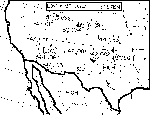
|
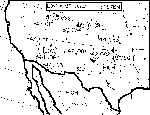
|
pertaining to this incident, the UFO should probably be tentatively identified as a weather balloon.
321-B. Niagara Falls, N. Y., 25 July 1957, 0025 LST. Weather: clear, excellent visibility. Observers saw a "circular brilliant white object with pale green smaller lights around its perimeter." Object appeared to move slowly at nearly constant altitude, and then went into a "fast, steep climb," disappearing in about 5-8 min. The object was tracked on a CPS-6B radar for about 3 min. moving from SW to NE, in agreement with prevailing winds in the area.
The rate of climb could not have been very great, or the object would not have remained in sight for "five to eight" minutes. The official AF view is that the object was a lighted balloon, and in the absence of other data or a more complete file on the case, there seems to be no more likely explanation.
1211-B. McChord AFB, Seattle, Wash., 2 October 1959, 0020-0320 LST. Weather: clear, fog moved in at 0150 LST after initial sighting, wind from 100 at 10 knots (approx.). Radar at McChord AFB picked up a total of five or more unidentified tracks between 0020 to 0320 LST. These targets appeared to be at elevation angles of about l0° -20° and azimuths of l70° -l90°. The range would change from 4,000 yd. to 8,000 yd., and the flight patterns were described as "erratic;" returns would occasionally appear in pairs. The radar blips were described as "weak." Data on the vertical beam width and the antenna pattern characteristics of the radar are lacking.
Visual observers were apparently told to go outside and look for an UFO at about 10° elevation and 190° azimuth. They found
one - "round," "the size of a quarter" (distance not specified), "white and blue flickering light," a rather good description of a scintillating star. There was a second magnitude star at precisely the correct azimuth (190°) at the time, although the elevation angle would have been only about 1° or so. A sharp temperature inversion, with mist trapped below it, could have easily produced the effect of larger size as well as increased the apparent elevation angle by about 1°. Even trained observers consistently over-estimate the elevation angle of objects near the horizon., as in the "moon illusion" (the apparent increase in size of the rising moon).
When "last seen," at about 0150 LST, the object was reported to be about 20° elevation and 170° azimuth. At that time another bright star (0.7 magnitude fainter than the first one) was located at about 172° azimuth and about 10° elevation, values commensurate with the apparent visual position (again, assuming over-estimate of elevation angle). Near the horizon these were the only two stars of third magnitude or greater in that part of the sky at that time.
The description of the radar targets, weak, erratic blips, together with the reported formation of a low-level fog (that hindered visual observations after 0150 LST), suggests the presence of a shallow temperature inversion-humidity trap that was producing AP echoes on the radar set. The UFO report states that temperature inversions were "prevalent" in the area.
In summary, this UFO incident appears to have been caused by radar AP echoes and associated visual star sightings, both observed at small angles through a surface temperature inversion-humidity trap layer.
103-B. Gulf of Mexico, off Louisiana coast (28° N 92° W), 6 December 1952, 0525-0535 LST (1125 GMT). Weather: clear, dry, light winds, visibility excellent, full moon. The radio refractivity
profile for Burwood, La., about 175 mi. NE of location of sighting, for 0900 LST is shown in Fig. 12; a very strong super-refractive layer is shown on this profile over a height interval extending from the surface to 456 m. (1,500 ft.). A sharp temperature inversion existed at the top of this layer. As an aircraft was returning to Galveston, Tex. at 20,000 ft. burn-off flares from oil refineries became visible. The radar was activated on 100 mi. range to check for the Louisiana coastline. The range to the nearest point on the coastline was about 89 mi. and assuming standard propagation conditions, the range to the radar horizon should have been on the order of 140 mi. Surprisingly, the coastline could not be seen on the radarscope. Instead a number of unusual echoes were observed. Initially there were four moving an a course of 120° true azimuth. These blips moved at apparent speeds of over 5,000 mph., coming within 15-20 mi. of the aircraft's position. Eventually they disappeared from the scope. The radar set was calibrated, but more blips appeared still moving SE across the scope.
Visual observations consisted of one or two blue-white flashes, one of which, as viewed from the waist blister, appeared to pass under a wing of the aircraft. All of these may have been above the horizon, since the wingtip would appear well above the horizon as viewed from this position. The observers stated that the flashes "did not alter course whatsoever." These visual sightings were probably Geminid meteors; the wing operations officer stated: "Visual sightings are indecisive and of little confirmatory value."
One of the radar witnesses stated: "One object came directly towards the center of the scope and then disappeared." After 10 min. of radar observation, a group of the blips merged into a half-inch curved arc about 30 mi. from the aircraft at 320° relative azimuth and proceeded across and off the scope at a computed speed of over 9,000 mph. After this, no more unidentified returns were noted on the radar.
The radar returns obtained in this incident were probably caused by the deep super-refractive layer near the surface shown in Fig. 12.
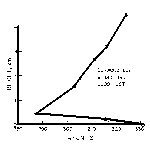
|
That this layer was present at the time and in the area is indicated by the failure of the aircraft radar to detect the Louisiana coastline even though burn-off flares on the shore were visible to the unaided eye. The layer was probably slightly stronger at the time of the incident, thus constituting a thick radio duct. A transmitter located above a radio duct and emitting a high enough frequency to be affected, as the radar undoubtedly was, does not excite propagation within the duct. This implies that the coastline below the duct would not be visible to the radar located above the duct.
The strange moving targets seen on the radar were probably caused by imperfections in the atmospheric layer forming the radio duct, allowing the radio energy to enter the ducting layer at various points. This would create sporadic ground returns. The returns may have been caused by a series of gravity waves running along the ducting layer in a SE direction; this is a phenomenon which is at present only poorly understood. In any event, spurious radar images have often been noted under propagation conditions of this sort, often moving at apparent speeds of from tens to thousands of miles per hour.
In summary, it seems most likely that the cause of this sighting can be assigned to radar AP, for which there is meteorological evidence, and meteors.
7-C. White Sands Missile Range, N. M., 2 March 1967, 1025-1132 LST. Weather: apparently clear (few meteorological data are available). A single witness at the summit of highway 70 over the Sacramento Mountains (Apache Summit, 9,000 ft. elevation) reported seeing "silvery specks" passing overhead from north to south. The witness called Holloman AFB, and range surveillance radar was requested to look for the objects. Two aircraft were scrambled, but neither reported a sighting, although they searched the area where the UFOs were reported.
Two radars were in operation. Both tracked a number of targets, most of which were stationary and so intermittent in nature as to prevent lock-on (see Case 16). Significantly, none of the radar targets was behaving in the manner described by this witness (i.e., moving steadily south at high altitude). Therefore, this incident is considered to be primarily a radar contact.
The probable nature of each of the three types of radar contact made is examined below.
190-N. Detroit, Mich., March 1953, about 1000 to 1100 LST (exact date and time unknown). Weather: "perfectly clear." A USAF pilot and a radar operator, flying in an F-94B fighter on a practice training mission, were directed by GCI radar at Selfridge AFB to intercept some unknown targets which appeared to be over
downtown Detroit. The pilot and radar operator looked in that direction and saw "tiny specks in the sky, which appeared to look like a ragged formation of aircraft."
The aircraft at this time was about 30 mi. NW of downtown Detroit, and the targets "appeared to be over the city's central section." The pilot turned the aircraft to an intercept course. During this time, perhaps "three or four minutes," the objects were visible to the pilot as "a ragged formation traveling slowly in a westward direction;" the objects appeared to be "a little lower than our aircraft." The pilot started his intercept run under full military power, without afterburner, at approximately 500 mph.
The pilot recalls thinking several times that details of the unknowns, like wings, tails, etc. should have "popped out" as they approached, so that identification could be made, but they did not. The ground radar had both the F-94B and the unknowns "painted as good, strong targets." The unknowns could still not be identified, but "seemed to get a little larger all the time."
The F-94B's radar operator began to get returns and "thought he was picking up the targets." The pilot looked at his instruments to see if he could "inch out a little more speed without going into after-burner," and when he looked up again "every last one" of the objects was gone. The pilot asked GCI where the UFOs were, and was told they were still there, "loud and clear." They continued to fly headings given by GCI right into the center of the targets, flying and turning in "every direction," but there was nothing in sight. The pilot states: "Gradually the targets disappeared from ground radar after we had been amongst them for three or four minutes." The F-94B then returned to base.
Since the exact date of this sighting is unknown, no applicable meteorological data are available. Any explanation of this incident
must therefore remain speculative in nature. If the UFOs are considered to have been material objects, then they would have had to have shifted position some tens of miles in the "two to four" seconds while the pilot was looking down at his instruments. This does not explain why they continued to appear on the ground radar. The only admissable hypothesis would seem to be that they became invisible as the fighter approached, but this does not account for the fact that they could not be picked up on airborne radar while the aircraft was searching the area.
There is one hypothesis that seems to fit all of the observed facts: that the "ragged formation" was actually an inferior mirage (see Section VI, Chapter 4). The angular conditions are satisfied: the objects appeared "slightly below the level of the aircraft," and reflections of the sky above the horizon would seem dark when seen projected against the hazy sky directly over the city. A layer of heated air, trapped temporarily below a cooler layer by a stable vertical wind shear, could produce a wavy interface that would reflect the sky in a few spots. This phenomenon is quite similar to the familiar road mirage. Like, a road mirage it suddenly disappears when one gets too close and the viewing angle becomes either too large or too small.
If the warm air below, the source of which would presumably have been the downtown area of Detroit, were also considerably moister than the cooler air above as is quite probable, then the radio refractive index would decrease quite suddenly across the inter-face. This would tend to produce anomalous propagation effects, including false echoes, on radar, and would explain why ground radar could continue tracking the unknowns when the pilot and airborne radar operator could no longer see them. The airborne radar, being immersed in the layer would probably not receive AP echoes of any duration other than, perhaps, occasional random blips.
After the aircraft had thoroughly mixed the opposing air currents by flying repeatedly through the interface as it searched for the targets, the ground radar returns would gradually fade away. This corresponds to what was actually observed.
In summary, without the data to make a more definitive evaluation of this case, the most likely cause seems to be a combined radio-optical mirage as described above. If so, this is another example of a natural phenomenon so rare that it is seldom observed: for a 0.25° critical mirage angle, the temperature contrast required is on the order of 10° or 15°C in the space of about 1 cm.
Weather: mostly clear, a few scattered clouds, visibility 10 to 15 mi., temperature 76° to 87°F, dewpoint 61° to 72°F, surface winds from SE, light, near surface, from 300° to 320° aloft, light. Radio refractive index profiles are shown in Figs. 13, 14, and 15, in Md., at an elevation of 88 m. (289 ft.) above sea level. There are a tremendous number of reports of UFOs observed on these two nights. In most instances visual observers, especially in scrambled aircraft, were unable to see targets indicated on ground radar, or to make airborne radar contact. Ground radar observers were often able to find a return in the general area of reported visual contacts, especially in the case of ground visual reports where only an azimuth was given. A few excerpts from typical reports during these incidents are given below:
Control tower operator, Andrews AFB, 0100 to 0500 EST, 20 July 1952:
An airman became excited during the conversation and suddenly yelled "there goes one." I saw a falling star go from overhead a short distance south and burn out. About two minutes later (the airman) said, "There's another one;
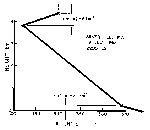
|
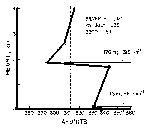
|
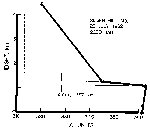
|
did you see the orange glow to the south?" I said I thought I saw it, but he pointed south and I had been looking south-west. I went up on the roof---and watched the sky in all directions. In the meantime Washington Center was reporting targets on their radar screen over Andrews. Andrews Approach Control observed nothing.
[The airman] was in the tower talking on the phone and interphones. He was watching a star and telling various people that it was moving up and descending rapidly and going from left to right, and [another airman] and I, listening to him from the roof, believed we saw it move too. Such is the power of suggestion.
This star was to the east slightly to the left of and above the rotating beacon. [The airman] reported the star as two miles east of Andrews and at an altitude of 2,000 ft.
A short time later, approximately 0200 hours, I saw a falling star go from overhead to the north. A few minutes later another went in the same direction. They faded and went out within two seconds. The sky was full of stars, the Milky Way was bright, and I was surprised that we did not see more falling stars.
All night Washington Center was reporting objects near or over Andrews, but Andrews Approach Control could see nothing, however they could see the various aircraft reported so their [radar] screen was apparently in good operation.
At 0500 hours Washington Center called me and reported an unknown object five miles southeast of Andrews field. I looked and saw nothing, That was the last report I heard.
A USAF Captain at Andrews AFB radar center:
At about 0200 EST Washington Center advised that their radar had a target five miles east of Andrews Field. Andrews tower reported seeing a light, which changed color, and said it was moving towards Andrews. I went outside as no target appeared on Andrews radar and saw a light as reported by the tower. It was between 10° and 15° above the horizon and seemed to change color, from red to orange to green to red again. It seemed to float, but at times to dip suddenly and appear to lose altitude. It did not have the appearance of any star I have ever observed before. At the time of observation there was a star due east of my position. Its brilliance was approximately the same as the object and it appeared at about the same angle, 10° to 157deg; above the horizon. The star did not change color or have any apparent movement. I estimated the object to be between three and four miles east of Andrews Field at approximately 2,000 ft. During the next hour very few reports were received from Washington Center. [According to Washington Center's account, however, the 0200 EST object was seen on radar to pass over Andrews and fade out to the southwest of Andrews -- G. D. T.] At approximately 0300 EST I again went outside to look at the object. At this time both the star and the object had increased elevation by about 10°. [The azimuth would have also increased about 10°, so that the observed change was apparently equal to the sidereal rate, 15° of right ascension per hour -- G. D. T.] The object had ceased to have any apparent movement, but still appeared to be changing color. On the basis of the second observation, I believe the unidentified object was a star.
The account of the airman referred to by the Andrews AFB control tower operator:
Airman [X] called the tower and reported he had seen objects in the air around Andrews; while we were discussing them he advised me to look to the south immediately. When I looked there was an object which appeared to be like an orange ball of fire, trailing a tail; it appeared to be about two miles south and one half mile east of the Andrews Range [station]. It was very bright and definite, and unlike anything I had ever seen before. The position of something like that is hard to determine accurately. It made kind of a circular movement, and then took off at an unbelievable speed; it disappeared in a split second. This took place around 0005 EST. Seconds later, I saw another one, same description as the one before; it made an arc-like pattern and then disappeared. I only saw each object for about a second. The second one was over the Andrews Range; the direction appeared to be southerly.
The account of a staff sergeant at Andrews AFB follows. He was apparently describing the same object that the radar center Captain had observed.
Later on we spotted what seemed to be a star north-east of the field, which was in the general direction of Baltimore. It was about tree top level from where I was watching. It was very bright but not the same color (as some apparent meteors). This was a bluish silver. It was very erratic in motion; it moved up from side to side. Its motion was very fast. Three times I saw a red object leave the silver object at a high rate of speed and move east out of sight. At this time I had to service a C-47 and lost sight of it for the night. The time was about 0330.
The visual sightings in these incidents seem to be either meteors, apparently quite numerous at the time, or stars, but a few descriptions are not adequate to make an identification and hence may represent unknowns.
The radar tracks reported, at various times, from Washington National Airport, Andrews AFB, and Bolling AFB are generally not correlated with each other, with airborne radar/visual observations, or with ground visual reports, except in a very general way, e.g., a star sighted on the azimuth supplied by the radar track.
An investigation of the radar tracks reported by Borden and Vickers (1953) is very informative. The authors observed, on the night of 13-14 August 1952, radar tracks very similar to those described in the 19-20 and 25-27 July incidents. The targets appeared to move with the upper winds at various levels at twice the observed wind speed, suggesting that they were ground returns seen by partial reflections from moving atmospheric layers of relatively small horizontal extent (i.e., patches of local intensification of a general super-refractive stratum). Borden and Vickers state:
The almost simultaneous appearance of the first moving targets with the [stationary] ground returns, [the latter] signifying the beginning of the temperature inversion, suggested that the target display was perhaps caused by some effects existing in or near the inversion layers.
The authors also relate similar target patterns observed during testing of a new radar at Indianapolis in November, 1952. They state:
Targets were larger, stronger, and more numerous than those observed by the writers during the Washington observations. At times the clutter made it difficult to keep track of actual aircraft targets on the scope.
In all major respects this report (Borden, 1953) is an excellent analysis of the probable radar situation during the July 1952, Washington sightings.
The atmospheric conditions in existence at the times of these UFO incidents, as shown in Figs. 13, 14, and 15, are rather peculiar. Refractivity profile for 19 July 2200 LST shows a surface inversion of l.7° C (3.1° F) but the resulting refractivity gradient is only -81 km-1, about twice the "standard" value. There is a rather unusual subrefractive layer at 3833 to 4389 m. produced by overlying moist air. Relative humidity drops from 84% at surface to 20% at base of this layer, then climbs to 70% at top of the layer. A number of significant levels are missing from this profile, which is common in 1952 Silver Hill profiles, but even so it is indicative of unusual atmospheric conditions. The radar sightings were made between 2340 LST and 0540 LST (July 20), and the atmospheric stratification was no doubt more strongly developed by that time. In addition, Silver Hill is at an elevation of 88 m. (289 ft.) above MSL, whereas Washington National Airport is at an elevation of only 13 m. (43 ft.). The intervening 75 m. is precisely that part of the atmosphere in which some of the most spectacular super-refractive and ducting layers would be expected to develop. Indeed, records for 1945-1950, during which radiosonde upper-air soundings were launched from Washington National Airport, reveal a much stronger tendency for the formation of anomalous propagation conditions than the Silver Hill data.
The profiles for 25 July and 26 July, 2200 LST are more complete than the 19 July profile, although some significant levels were noted as missing from the 26 July profile. Otherwise, the foregoing comments apply to these profiles as well. The 25 July profile shows a super- refractive surface layer and a strong elevated duct; there is a 4.6°C (8.3° F) temperature inversion through the elevated duct. It is perhaps significant that unidentified radar targets began appearing at 2030 LST
on 25 July. The 26 July profile has a l.2° C (2.2°F) surface inversion without a humidity lapse sufficient to cause super-refraction; however, a 0.9° C inversion between 1115 and 1275 m. is associated with a sharp humidity drop and a resulting elevated duct with a gradient of -167 km-1. This elevated layer is quite strong enough to produce AP effects on radar. Unidentified radar targets began appearing at 2050 LST on 26 July and continued until after midnight.
In summary, the following statements appear to be correct:
Weather: clear, temperature 61° F to 70°F, wind at surface: light from WSW. This is classed as primarily radar since the bulk of the reports were from radar and the first visual object was never described. The refractivity profiles for Topeka, Kans. and Oklahoma City, Okla are shown in Figs. 16 and 17.
During the early morning hours of 2 August 1965, the Wichita Weather Bureau Airport Station was contacted by the dispatcher of the Sedgwick County Sheriffs Department with regard to an object sighted in the sky near Wellington, Kans. (25 mi. south of Wichita). The radar operator, Mr. John S. Shockley observed what appeared to be an aircraft target near Udall, Kans., 15 mi. northeast of Wellington. This target moved northward at 40 to 50 mph.
During the next hour and a half several of these targets were observed on the radar scope over central Kansas moving slowly northward occasionally remaining stationary, or moving about erratically.
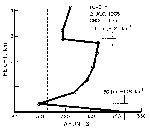
|
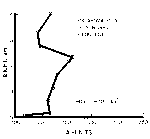
|
Mr. Shockley checked with the Wichita Radar Approach Control, however they were not able to observe a target simultaneously, with the exception of one aircraft south of McConnell Air Force Base near Wichita.
Later, a target was observed about seven miles NNW of Wellington, Kans., moving slowly southward. The Wellington Police Department was contacted and two officers went three miles west of the city, to see if they could observe anything. The target passed about one mile west of the city as observed on radar. The officers did not observe it until it was southwest of the city. They described it as a greenish-blue light that moved slowly away from them.
The dispatcher called again, with a report that two officers at Caldwell, Kans. (35 mi. south of Wichita) had sighted an object near the ground east of the city. A target was observed about two miles northwest of the city that moved northward and disappeared.
At daybreak, the dispatcher reported that the Wellington officers had an object in sight east of the city. Radar indicated a target in that area moving southward about 45 mph. Four or five people stopped their cars and watched the object with the officers. It was described as an egg-shaped object about the size of three automobiles, made of a highly polished silver metal.
Shortly after 0600C, a target was observed five miles north of Wellington moving southward. The target moved directly over the city to a point ten miles south of the city where it disappeared. The officers in Wellington were contacted but were able to observe absolutely nothing in the sky overhead during that time.
The radar was operated in long pulse, at 50 mi. range, with STC off. The targets were coherent and appeared from six to nine thousand feet on the RHI scope during the early morning and about four or five thousand feet later in the morning.
The descriptions of most of the visual objects in this sighting are too cursory to allow for any reasonable conjecture as to the real
nature of the objects. One of the objects, described as "a greenish-blue light that moved slowly away," may have been a star.
In most instances the radar targets did not seem directly related to the visual UFOs. This is characteristic of radar anomalous propagation returns.
The refractivity profiles both show highly refractive surface layers, with a 6.7° C (12.1° F) surface inversion at Topeka and a 9.7°C (17.5°F) surface inversion at Oklahoma City. In addition, the Topeka profile shows a strong elevated layer at 2720 m. with a 0.6°C inversion. The temperature inversion at Oklahoma City produced a surface layer having an optical refractivity gradient (at 5570Å of -101 km-1; this layer would extend the theoretical optical horizon for the eye of an observer 2 m. above the surface of a smooth earth from the normal value of 5.6 km. (9 mi.) to 8.5 km. (about 14 mi.). Such inversions can produce many strange effects, including the visibility of objects normally well below the horizon.
In summary, since the atmospheric conditions were conducive to anomalous radar propagation, and the radar targets displayed AP-like characteristics, this incident may probably be classified as consisting of radar false targets, with associated optical sightings that may have been enhanced by a strong temperature inversion at the surface.
19-B. Walesville-Westmorland N. Y., 1-2 July 1954, 1105-1127 LST. Weather: apparently clear. On 1 July 1954 reports came into the AF Depot at Rome, N. Y. of an UFO having the appearance of a balloon. The officer in charge said he believed it to be a partially deflated
balloon, and if it were still there the next day, he would have it investigated.
On 1105 LST 2 July 1954, F-94C aircraft 51-13559 took off on a routine training mission. GCI requested the aircraft to change mission to intercept an unknown aircraft at 10,000 ft. The pilot identified a C-47 aircraft by tail number, and was then requested to check a second unidentified aircraft that was at low altitude and apparently letting down to land at Griffith AFB. The AF account states:
As the pilot started a descent, he noted that the cockpit temperature increased abruptly. The increase in temperature caused the pilot to scan the instruments. The fire warning light was on and the pilot informed the radar observer of this fact. The fire warning light remained on after the throttle was placed in "idle" so the engine was shut down and both crew members ejected successfully.
The aircraft crashed at the "Walesville Intersection," and was destroyed. The aircraft struck a house and an automobile, fatally injuring four persons.
The above account is from the official USAF accident report ("Summary of Circumstances"). There is no Blue Book file because no UFO was involved.
Conclusion:
93-B. Wright-Patterson AFB, Ohio, August 1952, 1050-1113 LST. Weather: scattered clouds at 25,000 ft. This case, occurring almost over Project Blue Book's home base, is a very good example of confusion or contradictory evidence tending to obscure the true nature of a UFO incident.
At 1051 LST an unidentified radar track appeared 20 mi. NNW of Wright Patterson AFB on the 664th AC&W Squadron's GCI radar at
Bellefontaine. The radar operator stated that the course was 240° at 400 knots. Elsewhere the report states 450 knots; how he determined this is not made clear. Two F-86 aircraft from the 97th Fighter-Interceptor Squadron, Wright-Patterson AFB, were vectored in and made visual contact at 1055 LST. Fighters stayed with the object until 1113 LST. The F-86s climbed to 48,000 ft., fell off, and made a second climb. One aircraft had airborne radar activated and received a "weak" return. The object was described as "silver in color, round in shape," and its altitude was estimated as 60,000-70,000 ft. The object appeared on the radar gunsight film as a "fuzzy, small image ... with discernible motion ... that could be any darn thing."
In this incident it is apparent that
All of the evidence points to a weather balloon except for the 400-450 knot speed, and the 240° flight path, which is against the prevailing upper winds. Known aircraft were ruled out because of the altitude. A U-2 would "fit," but the first one was not flown until 1955, and the visual appearance was all wrong. The radar returns eliminated astronomical objects, mirage was ruled out because of the high angles, and the sighting occurred "above the weather." The conclusion was: unknown.
However, buried deep in the report was the radar operator's note that "At the time it was dropped (1113 LST) object was five miles northwest of Springfield, Ohio." This allows the UFO's course to be plotted on a map; Figs 18 and 19, shows such a map plot. It is readily apparent from this that the UFO's true heading was about 111° at an average speed of only 44 knots. Apparently no one thought to make this simple check. Since the highest reported winds from the radiosonde launched at Dayton at 1000 LST were 260°/31 knots
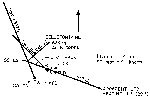
|
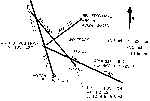
|
at 50,000 ft. and 270°/33 knots at 55,000 ft. the plotted track of the UFO is consistent with the observed upper winds. The blip was first "painted" at a 240° azimuth, which may explain where that quantity originated in the UFO movement report.
Conclusion: almost certainly a weather balloon. Note that the winds reported for the Wright-Patterson AFB 1000 LST show winds blowing first from the east, then from the SSE, ultimately from the west at higher altitudes. These winds were blowing in such a manner that it is conceivable that Wright-Patterson's own radiosonde balloon may have been the UFO in this incident.
76-B. Near Charleston, W. Va., 4 May 1966, 0340 LST. Weather: Severe thunderstorms in area. Pilot of a Braniff Airlines Boeing 707 flying at 33,000 ft. observed on his left side what appeared to be a fast-flying aircraft with landing lights. Braniff's airborne radar recorded this unknown. Pilot requested the radar operator at Charleston sector of Indianapolis ARTC to look for traffic at his 8:30 or 9:00 position, and the radar picked up a track in this position. Return made a sweeping turn and disappeared off scope to the southwest.
An American Airlines pilot flying 20 mi. behind the Braniff plane saw the object. It appeared to him to be a normal aircraft with landing lights. This pilot stated he had often seen such aircraft with lights during AF refueling missions.
Estimated speed of the unknown was 750-800 mph. No unusual maneuvers were performed or any that were beyond known military aircraft capabilities at the time. AF explanation is that the unknown was an aircraft with landing lights on. This is consistent with the reported facts.
Case 2. Lakenheath, England, 13-14 August 1956, 2230-0330 LST. Weather: generally clear until 0300 LST on the 14th. (For details see Section IV.)
The probability that anomalous propagation of radar signals may have been involved in this case seems to be small. One or two details
are suggestive of AP, particularly the reported disappearance of the first track as the UFO appeared to overfly the Bentwaters GCA radar. Against this must be weighed the Lakenheath controller's statement that there was "little or no traffic or targets on scope," which is not at all suggestive of AP conditions, and the behavior of the target near Lakenheath -- apparently continuous and easily tracked. The "tailing" of the RAF fighter, taken alone, seems to indicate a possible ghost image, but this does not jibe with the report that the UFO stopped following the fighter, as the latter was returning to its base, and went off in a different direction. The radar operators were apparently careful to calculate the speed of the UFO from distances and elapsed times, and the speeds were reported as consistent from run to run, between stationary episodes. This behavior would be somewhat consistent with reflections from moving atmospheric layers -- but not in so many different directions.
Visual mirage at Bentwaters seems to be out of the question because of the combined ground and airborne observations; the C47 pilot apparently saw the UFO below him. The visual objects do not seem to have been meteors; statements by the observers that meteors were numerous imply that they were able to differentiate the UFO from the meteors.
In summary, this is the most puzzling and unusual case in the radar-visual files. The apparently rational, intelligent behavior of the UFO suggests a mechanical device of unknown origin as the most probable explanation of this sighting. However, in view of the inevitable fallibility of witnesses, more conventional explanations of this report cannot be entirely ruled out.
Kincheloe AFB, Sault Saint Marie, Mich., 11-12 September 1967, 2200-2330 LST. Weather: clear, ceiling unlimited, visibility unlimited (over 20 mi.), no thunderstorms in area, wind at surface 140°/4 knots, aloft 240°-27O°/15-35 knots. The radio refractivity profile from Sault Saint Marie for the most applicable time is shown in Fig. 21.
This is a good example of moving radar targets that cannot be seen visually, where there is a "forbidden cone" over the radar site. Some of the returns were even seen to approach within 5-15 mi. of the radar and disappear, apparently subsequently reappearing on the other side of the radar scope at about the same range that they disappeared. This sort of behavior is symptomatic of AP-echoes.
The meteorological data tend to confirm this interpretation. The refractivity profile shown in Fig. 21 displays three peculiarities: a strong subrefractive layer at the surface, a strong elevated duct at 325-520 m. (about 1100-1700 ft.) and a super-refractive layer at 1070-1360 m. (about 3,500-4,500 ft.). A ray-tracing is shown for this profile in Fig. 20. The ray shows noticeable changes in curvature as it passes through the different layers, an indication that strong partial reflections would be expected. With this profile, moving AP-echoes, produced in the manner described by Borden and Vickers (1953), could be expected to appear at apparent heights of between 2,000-3,000 ft. and 7,000-9,000 ft. No height information was supplied with this report, so the calculation above cannot be verified.
In summary, it appears that this is a case of observations of moving AP-echoes produced by unusually well stratified atmospheric conditions.
156-B. Gulf of Mexico, Coast Guard Cutter "Sebago," 25"47'N 89° 24'W, 5 November 1957, 0510-1537 LST. Weather : not given, but apparently some clouds in area. The most applicable radio refractivity
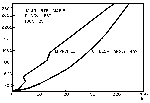
|
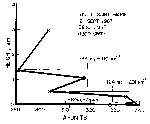
|
data available are for Key West, Fla. 0600 and 1800 LST, 5 November 1957. They are shown in Figs. 22 and 23. One visual and three radar objects were included in this case. The ship's heading was 23° true. The first contact was a radar blip picked up at 0510 LST at 290° true azimuth, 14 mi. It moved south, approached the ship within 2 mi., and returned north along ship's port side. Contact was lost at 0514 LST. Average speed of this UFO was calculated as 250 mph. At 0516 LST a new blip was picked up at 188°, 22 mi.; this target departed at a computed 650 mph., disappearing at 0516 LST at 190°, 55 mi. The third radar target was acquired at 0520 LST at 350°, 7 mi.; it appeared to be stationary. While the third radar target was being watched on the scope, a visual object was observed for about 3 sec. at 0521 LST travelling from south to north at about 31° elevation between 270° and 310° azimuth. The third radar target remained stationary for about 1 min. and then slowly moved to the northeast, finally accelerating rapidly and moving off scope at 15°, 175 mi.
The visual object was described as "like a brilliant planet;" it was undoubtedly a meteor, and in any event obviously was unrelated to radar target number three, the only radar target visible at the same time.
The radar targets were, with the possible exception of the first one, erratic and unpredictable in their movements. The second and third radar blips appeared suddenly, well within the normal pick-up range of the ship's radar. These two blips were probably caused by anomalous propagation. The two Key West profiles, although taken at some distance from the ship's position, are indicative of rather unusual atmospheric conditions in the area. Indeed, the 1800 LST profile is probably one of the most unusual radio refractive index profiles that has ever been observed. The atmospheric structure was apparently one of alternating very wet and very dry layers. Patterns of this sort are often very stable in these subtropical latitudes,
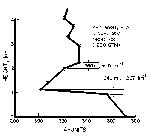
|
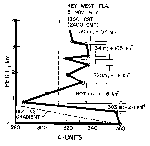
|
and tend to extend in rather homogeneous form over large horizontal distances. The ray-tracing of this profile, Fig. 23a, shows even greater changes in ray curvature. Strong partial reflections should be expected under these conditions.
The first radar target behaved generally like an aircraft, and the AF investigators were of the opinion that it was an aircraft, probably from Eglin AFB to the north.
In summary, the weight of evidence points toward anomalous propagation as the cause of the radar echoes, the first possibly being an aircraft. The visual object was apparently a meteor.
Coincidentally, the ship, SS Hampton Roads, at 27° 50'N 91° 12'W sighted a round, glowing object high in the sky that faded as darkness approached at 1740-1750 LST. This object appeared to move with the upper winds. AF investigators concluded that it was in all probability a weather balloon.
101-B. Canal Zone, 25 November 1952, 1806-2349 LST. Weather: generally clear, a few scattered clouds, ceiling and visibility unlimited, visibility at 2,000 ft. was 50 mi. Radio refractivity profiles for Balboa, 1000 and 2200 LST 25 November 1952, are shown in Figs. 24 and 25. Two unidentified objects were tracked by gun-laying radar during the period 1806-2349 LST. These objects, never present simultaneously, could have represented two tracks of the same object. The radar returns were described as "firm and consistent," and the objects were said to maneuver in a "conventional manner" at an average speed of 275 knots. Apparently the track speeds were as high as 720-960 mph. at times. Two B-26s, a B-17, and a PBM were scrambled but no radar or visual contact could be made with the unknowns. The UFOs were not spotted from the ground, with the exception of a single report that an officer saw, low in the sky, an "elongated yellow glow" giving a soft light like a candle. It moved quickly, disappearing in the

|
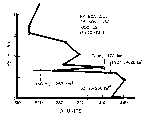
|
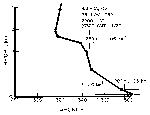
|
west in about 3 sec. There were scattered clouds. It seems possible that this was the sighting of a meteor seen through thin clouds producing the soft, yellow-glow effect. In any event, the description does not correspond with the simultaneous radar track of the first UFO.
With visibility of 50 mi. it seems strange that the scrambled aircraft could not sight either of the UFOs. The Air Force report comments:
It is believed that due to radar units being slightly off calibration and due to delay in communication, interceptors did chase their own tail or were sent to intercept themselves.
It is also believed that the majority of the radar plots were legitimate unidentified objects.
The preparing officer knows of no object which flies at 275 knots, that could remain in the Canal Zone area for nearly six hours, maneuver from 1000 through 28,000 feet altitude, make no sound, and evade interception.
In fact, it is difficult to imagine any material object that could accomplish all these feats. The strange radar tracks were probably the product of anomalous propagation conditions, an hypothesis that would account for the facts above. The atmospheric conditions were certainly favorable for AP, as can be seen from the A-profiles in Figs 24 and 25. However, there are two considerations that argue against this hypothesis.
Despite these two contradictions to the AP hypothesis, the lack of any visual corroboration of the two UFOs makes any other
hypothesis even more difficult to accept. This case therefore seems to fall, albeit inconclusively, into the classification of probable AP radar returns.
Case 21. Colorado Springs, Colo., 13 May 1967, 1540 LST (1640 MDT). Weather: overcast, cold, scattered showers and snow showers (graupel) in area, winds northerly about 30 mph., gusts to 40 mph., visibility air -- more than 15 mi. (Colorado Springs airport is not horizon-limited; visibilities of 100 mi. are routinely reported on clear days). This is a radar-only case, and is of particular interest because the UFO could not be seen, when there was every indication that it should have been seen.(See Section IV).
From the time the UFO was first picked up on radar to the time the Braniff flight touched down on runway 35, the UFO track behaved like a ghost echo, perhaps a ground return being reflected from the aircraft. This is indicated by the fact that the UFO blip appeared at about twice the range of the Braniff blip, and on the same azimuth, although the elevation angle appears to have been different. When Braniff touched down, however, the situation changed radically. The UFO blip pulled to the right (east) and passed over the airport at an indicated height of about 200 ft. As pointed out by the FAA, this is precisely the correct procedure for an overtaking aircraft, or one which is practicing an ILS approach but does not actually intend to touch down. Although the UFO track passed within 1.5 mi. of the control tower, and the personnel there were alerted to the situation, the UFO was not visible, even through binoculars. A continental Airlines flight, which was monitored 3-4 mi. behind the UFO at first contact, and was flying in the same direction, never saw it either.
Both the PAR and ASR radar transmitting antennas are located to the east of runway 35, and they are about 1,000 ft. apart on a SW-NE line. A ghost echo seems to be ruled out by at least the following considerations:
The radar flight characteristics of the UFO in this case were all compatible with the hypothesis that the unknown was a century-series jet (F100, F104, etc.), yet nothing was ever seen or heard.
This must remain as one of the most puzzling radar cases on record, and no conclusion is possible at this time. It seems inconceivable that an anomalous propagation echo would behave in the manner described, particularly with respect to the reported altitude changes, even if AP had been likely at the time. In view of the meteorological situation, it would seem that AP was rather unlikely. Besides, what is the probability that an AP return would appear only once, and at that time appear to execute a perfect practice ILS approach?
Case 35. Vandenberg AFB, Lompoc, Calif., 6-7 October 1967, 1900-0130 LST. Weather: clear, good visibility, strong temperature inversions near the surface caused by advection of very warm (80°-90°F), dry air over the cool ocean surface (water temperature 58°-59°F). This sighting begins with an apparent mirage (of a ship probably 60 mi. beyond the normal horizon) and continues with a very large number of unknown targets that were found on tracking radars which were being used in a search mode (they normally are not used in this way). The project case file contains a good analysis of the probable nature of the radar targets, some of which were apparently birds and some apparently ships tracked at 80 mi. ranges as well as other AP-like returns that
may have been associated with local intensification of the ducting layer. The nature of the visual objects is not as clear, although at least two of them appear to have been superior mirages of ships beyond the normal horizon. There were possibly some meteor sightings involved.
The meteorological conditions were quite interesting. The warm, dry air was apparently quite close to the water surface, at least in places. Data from Vandenberg and San Nicholas island indicate that in places the inversion was no thicker than about 90 m. (10 mb pressure difference). The contrast that may have existed can be calculated from these data:
| At or Near Sea Surface: | At 90 Meters or Less: | |
| Pressure: | 1004 mb | 994 mb |
| Temperature: °F: | 58°F | 90°F |
| Temperature: °C: | 14°C | 32°C |
| Temperature: °K: | 287°K | 305°K |
| Optical N (5570A) | 275 (ppm) | 256 (ppm) |
The optical refractive index gradient that may have existed at the time was therefore on the order of -210 ppm. km-1, or a somewhat greater negative value, depending upon the thickness chosen for the layer. The value above is computed as (256-275) /0.090, based on the 90 m. maximum thickness assumed. Since the critical value of the gradient for a superior mirage is -157 ppm. km-1, it is quite apparent that the conditions required for the formation of extended superior mirages were most likely present on the date in question. The only problem with this explanation is the reported elevation angle of 10°, but as pointed out in the conclusions to this chapter such estimates by visual observers are invariably over-estimated by a large factor.
In summary, the conclusions arrived at by the investigators in this case seem to be adequately supported by the meteorological data available.
The sighting reported for 12 October 1967, 0025 LST, seems to be a classic example of the description of a scintillating, wandering star image seen through a strong inversion layer. Note particularly the estimated ratio of vertical and horizontal movements. Two very bright stars would have been close to the horizon at this time: Altair, magnitude 0.9, would have been at 277° azimuth and about 4° elevation angle; Vega, magnitude 0.1, would have been at about 313° azimuth and about 12° elevation angle. Of the two, Altair seems the more likely target because of the smaller elevation angle; the observers gave no estimate of either azimuth or elevation angle.
A summary of the results of this investigation is given in Table 1.
The reader should note that the assignment of cases into the probable AP cause category could have been made on the basis of the observational testimony alone. That is to say, there was no case where the meteorological data available tended to negate the anomalous propagation hypothesis, thereby causing that case to be assigned to some other category. Therefore, a review of the meteorological data available for the 19 probable-AP cases is in order.
| Most Likely or Most Plausible Explanation | |||||
| Class | Anomalous Propagation | Man-Made Device | Unknown | No UFO | Class Total |
| I-A | 6 | 1 | 2 | 0 | 9 |
| I-B | 2 | 1 | 0 | 0 | 3 |
| I-C | 1 | 0 | 1 | 0 | 2 |
| I-D | 0 | 4 | 2 | 0 | 6 |
| All Class I | 9 | 6 | 5 | 0 | 19 |
| II-A | 6 | 0 | 0 | 0 | 6 |
| II-B | 4 | 2 | 2 | 1 | 9 |
| All Class II | 10 | 2 | 2 | 1 | 15 |
| All Classes | 19 | 8 | 7 | 1 | 35 |
refractive index profiles, i.e., they are conducive to anomalous propagation effects. The a priori probability of such a result, from a truly random sample of dates-times-places is roughly on the order of one chance in 200,000 (assuming that the probability of clear weather is roughly 0.5 in any single case).
In overall summary of these results, as they pertain to anomalous propagation of radio or optical waves, it seems that where the observational data pointed to anomalous propagation as the probable cause of an UFO incident, the meteorological data are overwhelmingly in favor of the plausibility of the AP hypothesis. That this result could have been only coincidental has been shown to be only remotely probable.
The following conclusions can be stated as a result of the investigation reported in this chapter:
height-range, these values often turn out to be equivalent to elevation angles of only a degree or two. There seems to be a sort of "quantum effect" at work here, where an object must be either "on the horizon" (i.e., at 0° or at an elevation of greater than 10°.
A number of recommendations for future UFO investigative procedures are indicated by the results of this chapter:
data for a sighting months or years after the fact. Copies of original radiosonde recordings should be obtained for the closest sites, since these may be analyzed in more detail than that routinely practiced by weather bureaus for synoptic purposes. It should be emphasized that, for example, a nighttime profile is usually more germane to a nighttime sighting than is a daytime profile. For example, if an UFO incident occurs at 2100 or 2200 LST, an 0600 LST (next day) raob will generally be more pertinent to the propagation conditions involved than will an 1800 LST raob. The converse is also true.
Bean, B. R., B. A. Cahoon, C. A. Samson, & G. D. Thayer. A World Atlas of Atmospheric Radio Refractivity, ESSA Monograph No. 1, U.S.G.P.O., (1966).
Bean, B. R., & E. J. Dutton. Radio Meteorology, National Bureau of Standards Monograph No. 92, U.S.G.P.0., (1966).
Borden, R. C., and T. K. Vickers. "A Preliminary Study of Unidentified Targets Observed on Air Traffic Control Radars," CAA Technical Development Report No. 180, (1953).
Minnaert, M. The Nature of Light and Colour in the Open Air, New York City, N. Y.: Dover, 1954.